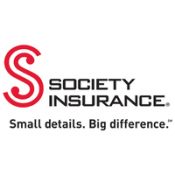Six Concepts Every Restaurant Employee Handbook Should Cover
5 Min Read By Society Insurance
The idea of creating a well-thought, engaging employee handbook isn’t why restaurateurs go into the food industry. However, spending the time to create a handbook will help create the desired culture, as well as save time and money (helping to avoid employee turnover as 36 percent of employees say they quit because they wish they had better training, legal action, safety concerns). We've detailed six concepts that every restaurant employee handbook should cover to create a well-oiled machine.
1. Elements from the ServSafe Certification
Keep the vital ServSafe items top of mind such as food handling, good personal hygiene and sanitizing. Other key elements from the food and alcohol safety training include:
-
The importance of food safety
-
How to prevent cross-contamination
-
Safe food preparation
-
Storing food
-
Methods of thawing, cooking, cooling and reheating food
-
HACCP (Hazard Analysis and Critical Control Point) food safety regulations
2. Procedures for Operating Restaurant Equipment (if applicable)
Safety elements are the most important components of your employee handbook. This is not only important for the safety of your employees and customers but also for your bottom line in the form of limiting liability.
For employees operating restaurant equipment, outline standard operating procedures, such as:
-
Do not wear loose clothing or jewelry that could become caught in machinery. For long hair, use a hair net to keep out hair that could become caught in machinery.
-
Use equipment properly. All pieces of equipment should be used according to the manufacturer’s instructions.
-
Avoid electrical hazards. Keep electrical appliances away from wet areas and check their cords for damage regularly. If the cord is damaged, stop using the appliance immediately until the cord is replaced.
-
Equipment should be cleaned thoroughly after every use in accordance with manufacturer instructions as well as all surfaces and workstations.
When operating mincers, choppers, dicers, meat slicers:
-
Always use push sticks or tamps to feed or remove food from these types of machines.
-
Do not use your hands to feed smaller pieces of meat through slicers.
-
Make sure you are using any machine guarding that is provided to prevent access to cutter blades. Do not bypass safety guards.
-
Do not open up or put your hands into an operating machine to stir contents or guide food.
-
Turn off and unplug the machine before disassembling and cleaning.
When operating food processors, mixers:
-
Do not attempt to remove items (for example, a spoon that falls into the mixture) from dough while the machine is mixing.
-
Do not open up the lids of processors to stir contents while food is processing.
-
Make sure the processor is off before opening the lid or adding items.
-
Turn off and unplug machinery before cleaning or removing a blockage.
-
Use any machine guards provided.
-
Do not wear loose clothing or jewelry that could become caught in machinery.
Remember: Child labor laws do not permit workers younger than 18 to work with or repair, adjust, or clean power-driven machinery like meat slicers and bakery mixers.
3. Fire Safety Standard Operating Procedures
Employees are responsible for following the safe work practices of their employers.
-
Extinguish hot oil/grease fires by using a class K fire extinguisher.
-
Never carry or move oil containers when oil is hot or on fire.
-
Never throw water on a grease fire; this will make the fire worse.
-
Empty grease traps frequently; do not allow them to overfill.
-
Understand the fire safety procedures in your workplace, including how to call for help, and follow them in a fire or other emergency.
-
Make sure that if you are working in a commercial kitchen that you know where to find and how to manually activate the cooking appliance fire suppression system.
-
Keep grilling surfaces clean and free from grease accumulations that might ignite and cause a fire.
-
Avoid cooking areas unless your work requires you to be there.
-
Do not use frayed cords or defective equipment.
-
Do not store flammable items near heat-producing equipment or open flames.
-
Know fire alarm locations.
-
Always sound an alarm, summon the fire department and activate the fixed fire suppression system first.
-
The fixed fire suppression system (manual pull station) is located on the wall (usually near an exit). When activating the system, simply follow the instructions noted on the pull station.
-
Know that if you catch fire, STOP, DROP and ROLL.
4. Substance Abuse Guidelines
As an employer, it’s up to you to determine a drug and alcohol use policy that protects your guests, other employees, and that protects you against liability.
A standard employee handbook entry could look like, “‘The Company’ explicitly prohibits:
-
The use, possession, solicitation for, or sale of narcotics or other illegal drugs, alcohol, or prescription medication without a prescription on Company or customer premises or while performing an assignment.
-
Being impaired or under the influence of legal or illegal drugs or alcohol away from the Company or customer premises, if such impairment or influence adversely affects the employee’s work performance, the safety of the employee or of others, or puts at risk the Company’s reputation.
-
Possession, use, solicitation for, or sale of legal or illegal drugs or alcohol away from the Company or customer premises, if such activity or involvement adversely affects the employee’s work performance, the safety of the employee or of others, or puts at risk the Company’s reputation.
-
The presence of any detectable amount of prohibited substances in the employee’s system while at work, while on the premises of the Company or its customers, or while on company business. ‘Prohibited substances’ include illegal drugs, alcohol, or prescription drugs not taken in accordance with a prescription given to the employee.”
5. Health and Safety Policies
Be very clear with your restaurant’s policies whether it’s the flu, injury or other health issues. At the bare minimum, employees are required to tell managers when they are sick. Managers and workers should not work when sick. Employees should not be at work if they are experiencing these symptoms:
-
Fever
-
General weakness
-
Nausea
-
Abdominal pain
-
Jaundice
-
Vomiting
-
Diarrhea
-
Pneumonia
-
Double vision
-
Difficulty speaking or swallowing
-
Tingling in throat
-
Coughing up worms
-
Reddening of the face and neck
-
Reversal of hot and cold sensation
-
Tingling in fingers, lips or toes
-
Joint and muscle pain
-
Dizziness
Employees with these symptoms require written clearance from the employee’s doctor or another health provider before they are allowed to get back to work and should be sent home immediately if they are experiencing these symptoms while at work.
6. How the Organization Handles Emergency Situations
Businesses across the country experience year-round unwelcome visits from Mother Nature, including wildfires, bitter cold, hail, torrential rain, gusty winds and more. These naturally occurring incidents can seriously harm an establishment’s employees, staff, structure and business operations. Should a natural diasaster happen,
-
Have a checklist. Depending on the type of natural disaster, you could have a few days or only a few hours to prepare. A checklist will help you quickly prepare for the incoming disaster. Some great resources that can help you create a checklist are ready.gov, fema.gov, and preparemybusiness.org.
If there’s a violence in the restaurant or a security risk,
-
Create and implement a violence prevention program, specific to your establishment. The plan should indicate how employees should notify local law enforcement agencies in case of an emergency.
-
Train employees to follow the safety plan when they are dealing with unsatisfied customers.
-
Instruct employees in reporting and logging incidents of threats or violence.
Should a fire break out in the restaurant,
-
Have a method of reporting fires and other emergencies.
-
Create an evacuation policy and procedure.
-
Develop emergency escape procedures and pre-assigned routes, such as floor plans and workplace maps.
In regards to helping customers or other staff during a medical emergency, (serious injury or illness), the following procedures should be used:
-
Assess the patient’s situation, then call 911
-
Do not move the victim unless he/she is in a life threatening environment
-
Notify the manager on duty
-
Render emergency first aid, if trained. If not trained, find someone who is.
-
Remain with the patient until first responders arrive
-
Write an accident report
Though an employee handbook will be a time investment on the front-end, it will pay the company back in dividends in creating a work environment where people feel safe.
This information is provided as a convenience for informational purposes only. This information does not constitute legal or professional advice. It is provided to assist you in recognizing potential unsafe work problems or conditions and not to establish compliance with any law, rule or regulation. This article is not a template. It is meant to be a guide as to the questions and issues that should be addressed when drafting a policy. For a legal opinion, please seek legal counsel from a qualified attorney.


